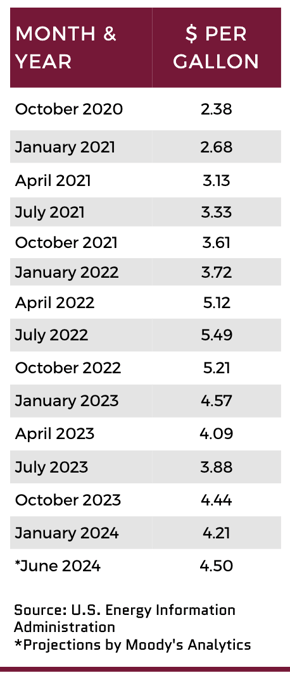Diesel Demand: The Outlook on 2024 Prices & The Impact on Development
Diesel prices have been softening over the past year, and their recent $4.06-per-gallon level is now well below the eye-popping $5.49 last seen in the summer of 2022 on the heels of the Russian invasion of Ukraine. But the good news comes with a caveat: The price tag for the truck fuel is expected to continue to exceed 2023 pricing through 2025.
Given that fuel costs can account for as much as 25 percent to 40 percent of a typical trucking operation’s total expenses, any shift in the price tag can have a real effect on the bottom line. So, what’s keeping prices high? A major contributing factor is the cost of oil, which is passed right along to the diesel distillate. “Today’s crude oil price of about $95 a barrel is being supported by the agreement on the part of Saudi Arabia and OPEC to maintain production at a level less than consumption,” said Allen R Schaeffer, executive director of the Diesel Technology Forum. “So prices are projected to remain at their current level through 2024.”
Tight diesel supplies are not helping matters. “Like other commodities, long- and short-term diesel price expectations are driven by supply levels,” said Trey Cowan, oil and gas analyst at the Institute for Energy Economics and Financial Analysis (IEEFA). “And right now, figures from the Energy Information Agency (EIA) show that we are tracking toward five-year lows.”
Capping Production
Given the popularity of diesel, one would expect refineries to pump out as much product as possible. But that’s not the case.
 As noted above, it behooves some countries to reduce output to bolster the price tag of an important export. Furthermore, there is a cost problem to consider: If pump prices drop too low, making the fuel is just not feasible.
As noted above, it behooves some countries to reduce output to bolster the price tag of an important export. Furthermore, there is a cost problem to consider: If pump prices drop too low, making the fuel is just not feasible.
“Over the years, refiners in the United States have reduced capacity due to poor margins and increased environmental costs, as well as to the expense required to maintain facilities in a world where United States’ demand has peaked,” said Andrew M. Lipow, president of Houston-based Lipow Oil Associates. “Refineries are shutting down as they look ahead to how much money they will have to spend to maintain safe and environmentally compliant facilities.”
Inflation, too, increases building costs. It can cost several hundred million dollars to bring a new refinery on line, at a time when oil demand in the U.S. is going down. (USEIA, the United States Energy Information Agency, projects diesel consumption to be flat in 2024). The prudent decision may well be to shut down, and Lipow noted that two more U.S. refineries on the West Coast and Gulf Coast are planning to do just that.
Supply Relief
Russia produces some 10 percent of the oil from which the world refines diesel, and its ability to move its product through alternative channels has helped mitigate the global diesel shortage. “The sanctions imposed by the European Union and the United States and other countries on the purchase of Russian crude oil and refined products has forced Russia to find new customers,” said Lipow. “While the majority of their oil is sold into China and India, they have found alternative markets in North Africa and Brazil.”
Too, there is a bit of supply relief from some new refineries in parts of the world where diesel demand is growing. “Over the past year, new refineries have come on stream in Kuwait, Oman, and China,” said Lipow. “There is one in Nigeria that has yet to come on line, and another in Mexico which may be producing fuel in 2024.” While the additional supply is welcome, it is meager. “These new refineries will only represent an increase of some 1.5 percet to 2.0 percent of world capacity.”
On the demand side, U.S. consumption is a mixed bag. Upward pricing pressure is coming from the travel sector, where the post-pandemic consumer continues to buy airline tickets in great numbers. “There’s no doubt that increased jet fuel demand has reduced, somewhat, the availability of diesel fuel,” said Lipow. Fuel for the nation’s aircraft is pulled from the same oil pool required for diesel.
At the same time, downward pricing pressure has come from the shipping industry. “Freight activity is a big driver of demand for diesel, and thus of prices,” said Schaeffer. “We have been experiencing a drop-off in freight demand, which is a result of supply chain issues finally being resolved. We’ve seen a number of trucking companies go out of business as a result.”
Current fuel prices are affected by consumer and business confidence. Here, again, there is an expectation for reduced diesel demand. “Right now, prices are not necessarily responding to the lower supply situation,” said Cowan. “That’s because people are focused on what the economies are going to look like both in the U.S. and abroad over the coming year. And right now it’s a kind of subdued outlook for demand globally.”
Green Power
Peeking around the corner as a partial solution to diesel shortages is the increased production of “renewable diesel,” an eco-friendly product made from vegetable oils and fats.
“The USEIA is projecting an increase of some 30 percent in the consumption of renewable diesel in 2024,” said Schaeffer. “That is huge, but most of it is going to displace petroleum usage on the West Coast, primarily in California, Oregon, and Washington. All of those states have low carbon fuel policies in place that require refiners to bring in increasing percentages of renewable low carbon fuels into the mainstream pool. Some of that displaced fuel will be available to users elsewhere in the country, so that will help moderate prices.”
Sometimes called “green diesel,” renewable diesel is virtually chemically equivalent to petrodiesel. That makes it a so-called “drop-in” replacement for the fossil fuel, which means it can be dropped right into a truck’s tank without needing to be blended with its carbon-based twin. That is a significant advantage over biodiesel, an alternative eco-friendly biomass-based fuel that can only make up from 5 percent to 20 percent of a petrodiesel blend.
Together, renewable diesel and biodiesel account for some 5 percent of U.S. diesel consumption. Renewable diesel production has recently surpassed that of biodiesel, and more growth is forecast. “A number of refineries have in the last three years announced they were transitioning some of their traditional petroleum refining processing into renewable diesel,” said Schaeffer. “Many mainstream oil companies are putting their fingers into renewable diesel at some level, which will help boost growth.”
At the federal level, tax credits are encouraging producers to produce more renewable diesel.
Diesel Vs. Electricity
Given the need to meet federal and state energy mandates, the trucking sector is starting to pay more attention to the potential usage of renewable diesel as an alternative to electricity. “There are several things preventing the long-haul trucking industry from adopting electric vehicles (EVs),” said Brian Guinn, CEO of United Energy Corporation, a diversified oil and gas producer based in Plano, Texas. “One is a lack of a sufficient number of charging stations. Another is the fact that the heavier the load the fewer miles an electric truck can travel before charging is necessary.”
Even if the requisite charging stations are built, using them can prove a costly disruption to truckers’ schedules. “These guys already spend more than three quarters of their lives on the road,” noted Guinn. “If they have to stop an additional two or three times on a typical trip, electric power will not be effective.”
There is also a problem of range in those parts of the country subject to cold seasons. “The batteries have a tendency to degrade in their performance in cold weather,” said Ed Hirs, an energy fellow at University of Houston. “And so, while it’s reasonable to assume that electric trucks can shoulder the load in temperate regions such as California, Texas, Arizona, and all across the south, it’s not so certain that they will do very well in the northern climates during the winter.”
For all of these reasons, it seems that EVs are a viable option for truckers only if they are traveling relatively short distances and coming back to their home base to charge up. “We will see some city garbage trucks transition to electricity a lot sooner than we will over-the-road, long-haul vehicles,” said Guinn.
Even for short-haul trucks, though, there remains a capital investment problem. “If you buy a fleet of trucks, you’re hoping to use them for three or four years and then sell them to recoup part of your investment to buy a new fleet,” said Guinn. “The problem with EVs is that the upfront cost of these vehicles is so high that the old investment model no longer works. You’re not dealing with engines anymore. You’re dealing with rare earth minerals and extremely expensive lithium batteries.”
Adding to the problem: EVs do not last as long as traditional vehicles, which might be usable for 15 or 20 years by a number of owners.
In effect, buying EVs that are twice the price of regular trucks amounts to transferring saved fuel costs to the beginning price of the new equipment. Guinn said that what we might end up with is a kind of “vehicle-as-a-service” model where leasing companies provide such trucks to end users.
–
New York-based freelancer Phillip M. Perry negotiates win-win deals with his clients everywhere.
More Content
Popular Posts
The self storage industry is in a precarious...
Joe Shoen, CEO of U-Haul, has had enough.
Like its name implies, Surprise, Ariz., a...
Joe Shoen has had enough.
In a record-breaking deal finalized May 12,...
Senate Bill 709 (SB709) has many in the...
Donald Trump has just reclaimed the White...
The question of “abandonment” of stored...
Self-storage operators wear a lot of hats....
In 1992, Clinton strategist James Carville...
Recent Posts
When Neville Kennard left for a work trip to...
Self-storage software is no longer...
The self-storage industry continues to...
Fires in California. Tornadoes in Kansas....
From policy pivots in Ottawa to tariff...
Self-storage operators have struggled to...
Their signature red coats may draw attention...
Nailing down Josh and Melissa Huff for an...



















